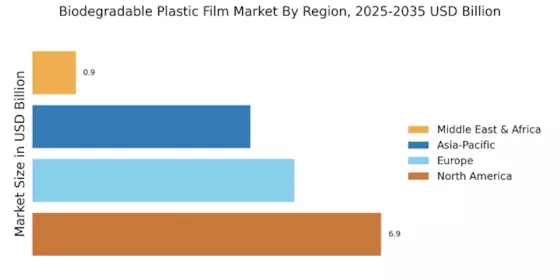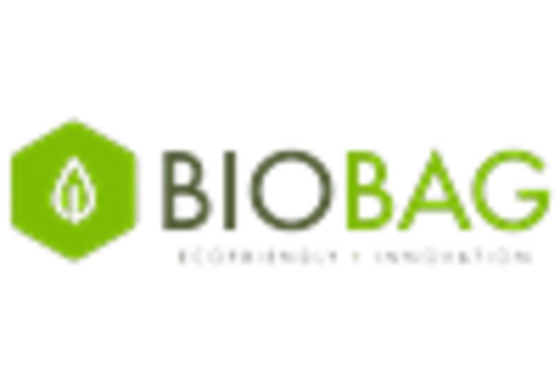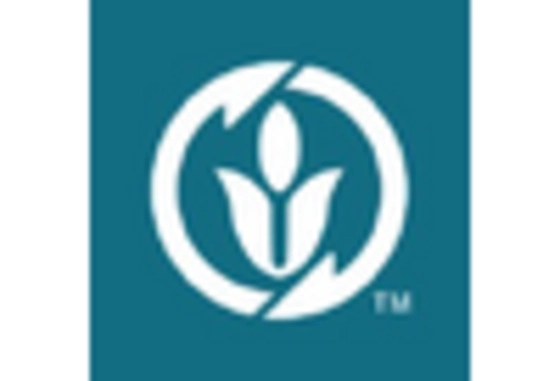Increasing Environmental Awareness
The rising consciousness regarding environmental issues among consumers is a pivotal driver for the Biodegradable Plastic Film Market. As individuals become more informed about the detrimental effects of traditional plastics on ecosystems, there is a marked shift towards sustainable alternatives. This awareness is reflected in consumer preferences, with a significant percentage indicating a willingness to pay a premium for biodegradable products. In fact, recent surveys suggest that over 70% of consumers prioritize eco-friendly packaging options, thereby propelling the demand for biodegradable plastic films. Companies are responding to this trend by innovating and expanding their product lines to include biodegradable options, which further stimulates market growth. The increasing environmental awareness not only influences purchasing decisions but also encourages manufacturers to adopt sustainable practices, thereby enhancing the overall appeal of the Biodegradable Plastic Film Market.
Government Initiatives and Regulations
Government policies and regulations aimed at reducing plastic waste are crucial drivers for the Biodegradable Plastic Film Market. Many countries have implemented stringent regulations to limit the use of conventional plastics, thereby creating a favorable environment for biodegradable alternatives. For instance, several regions have introduced bans on single-use plastics, which has led to a surge in demand for biodegradable films as viable substitutes. Additionally, government incentives for companies producing eco-friendly products further bolster market growth. The financial support and subsidies provided to manufacturers of biodegradable materials encourage innovation and production capacity expansion. As a result, the regulatory landscape is increasingly favorable for the Biodegradable Plastic Film Market, fostering a shift towards sustainable packaging solutions that align with environmental goals.
Technological Innovations in Production
Technological advancements in the production of biodegradable plastics are significantly influencing the Biodegradable Plastic Film Market. Innovations in material science have led to the development of new biodegradable polymers that offer enhanced performance characteristics, such as improved strength and flexibility. These advancements not only make biodegradable films more competitive with traditional plastics but also expand their applications across various sectors, including agriculture, food packaging, and consumer goods. The introduction of novel production techniques, such as bio-based feedstock utilization and advanced processing methods, has further reduced production costs, making biodegradable films more accessible to manufacturers. As technology continues to evolve, it is likely that the Biodegradable Plastic Film Market will witness an influx of innovative products that cater to diverse consumer needs, thereby driving market expansion.
Rising Demand from the Agricultural Sector
The agricultural sector's increasing demand for biodegradable plastic films is a notable driver for the Biodegradable Plastic Film Market. These films are utilized in various applications, including mulch films, greenhouse covers, and seedling trays, which contribute to enhanced crop yields and reduced environmental impact. The adoption of biodegradable films in agriculture is driven by the need for sustainable farming practices that minimize plastic pollution in soil and waterways. Recent studies indicate that the use of biodegradable films can lead to improved soil health and reduced reliance on chemical fertilizers. As farmers seek to adopt more eco-friendly practices, the demand for biodegradable plastic films is expected to rise, thereby propelling the growth of the Biodegradable Plastic Film Market. This trend underscores the potential for biodegradable solutions to address both agricultural efficiency and environmental sustainability.
Consumer Preference for Convenience and Functionality
Consumer preferences for convenience and functionality are increasingly shaping the Biodegradable Plastic Film Market. As lifestyles become more fast-paced, there is a growing demand for packaging solutions that offer ease of use while being environmentally responsible. Biodegradable plastic films provide a practical alternative, combining the convenience of traditional plastics with the added benefit of being eco-friendly. This dual appeal is particularly evident in sectors such as food packaging, where consumers seek products that are not only sustainable but also maintain freshness and quality. Market data indicates that the demand for biodegradable packaging solutions is projected to grow at a compound annual growth rate of over 15% in the coming years. This trend suggests that as consumers continue to prioritize convenience alongside sustainability, the Biodegradable Plastic Film Market will likely experience robust growth, driven by innovations that cater to these evolving preferences.


















Leave a Comment